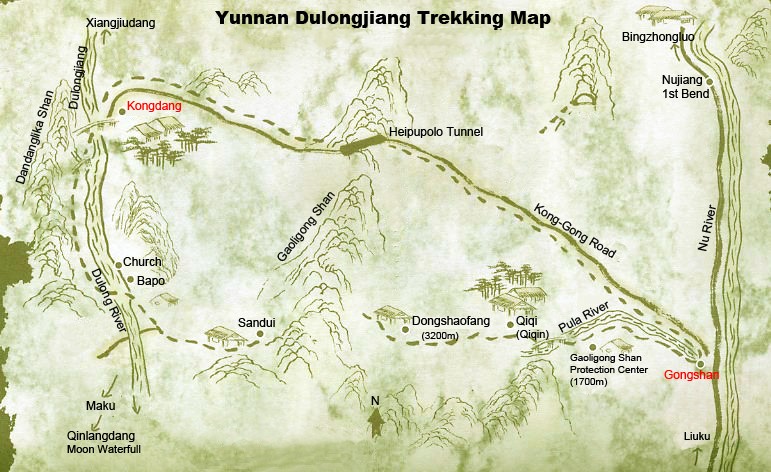Dulongjiang River Valley Trekking Guide
Dulongjiang Overview
Dulongjiang, also Dulong River , originates from Tibet, flowing through the northwest corner of Yunnan then into Burma. Its Yunnan section is about 80km long, sandwiched by Mt. Dandanglika on the west and Mt. Gaoligong on the east. Amongst the lofty mountains bordering Tibet and Yunnan is the Dulong River Vallley, at the west slope of the north part of the Gaoligong Shan.
The Dulongjiang Valley is where the 3 ethnic minorities – Dulong(Drung), Nu, Lisu, inhabit for ages. It lures adventurous travelers with its isolated natural beauty, original ethnic cultures and a mystical facial tattoo tradition. A dirt road connects the valley to the nearest town, Gongshan.
To outsiders, the valley is often known as “the Valley of Death”. Due to the heavy snowfall,transport to the valley is blocked for more than six months each year.It’s definitely an exciting adventure to trek into this isolated and mysterious valley. The closest Tibetan village is more than three days walk with almost no services of any kind. The destination doesn’t offer much more comfort than the trial.
Best Time to go – September to October
Kunming->Liuku or Fugong-> Gongshan-> Kongdang. There are a few options to arrive Gongshan from Kunming.
Kuming -> Liuku:580km, express and sleeper buses leaving from Kunming daily from 8am till 6pm, fare ranging from Y110-160, 13hrs ride. There are also buses from Dali(8hrs) and Baoshan(4hrs) to Liuku.
Kunming -> Gongshan: a sleeper bus departing from Kunming Xiyuan Bus Station at 18:00 daily, 830km/ 18hrs/ Y145-160.
Tips: Take the Liuku, Fugong or Gongshan bus either at West Bus Station or Xiyuan Bus Station in Kunming. Sleeper buses with license at these two bus stations always have destinations printed on the top of their front screen.
Liuku<-> Gongshan(200km):4 buses run between along the spectacular gorge.
Fugong <-> Gongshan (111km)
From Fugong, there are regular buses and vans to Gongshan, the next major town north. Most of them are in the morning around 9am. In addition, the Liuku-Gongshan bus passes Fugong around 11am every morning; just wait outside the bus station for them. Ride to Gongshan is about 2 .5 hours costing 20Y.
Buses leave Gongshan for Fugong and Liuku in the morning. Latest buses are scheduled at 11:50 and 13:00. It is reported that the 13:00 bus is often suspended.
Gongshan <-> Kongdang(also Kongmu)
Kongdang, the village seat of Dulongjiang, is the last point vehicles can reach via Kongdang-Gongshan Road in the valley. Transport from Gongshan to Kongdang is mainly vans and jeeps that run when reasonably full. The 96km bumpy dirt road journey takes 6-7hrs.
Trekking in Dulongjiang
> Dulongjiang Trekking Map

Route A: Kongdang<-> Xiangjiudang<- > Kongdang
This is the easiest north route, a round walk takes about 3 days. Xianjiudang is where leeches attack trekkers. Leg wrapping and salt should be brought to keep leeches away.
Route B: Kongdang<-> Xiangjiudang<- > Longyuan <-> Dizhengdang <-> Xiongdang
Route C: Gongshan -> Qiqi(其期)-> Dongshaofang(东哨房)-> Bapo(巴坡)-> Kongdang(孔当)-> Gongshan
Route D: Gongshan -> Qiqi-> Dongshaofang-> Bapo(巴坡)-> Houmu(3rd village)-> Xianjiudang(献九当)-> Longyuan(龙元)-> Dizhengdang(迪政当)-> Nandai(南代) -> Kongdang-> Gongshan
Accommodation en Route
Very basic lodgings are available at Bapo, Maku and Kongdang for Y15/night, schools or villge-committee offices also provide beds for around Y10-15 per night.
Dulong Ethnic Minority
The Dulong (also known as Drung) ethnic group is one of the smallest ethnic groups in China. With a total population of about 7000, the Dulongs mainly live in the Dulong River Valley in the Gongshan Dulong and Nu Autonomous County in northwest Yunnan. There are also a small number of them, about 10 percent of the total, distributed in the areas along the Nujiang River in the north of Gongshan County.
History
Few historical records were found regarding the origin of this ethnic group till today. But relative references show that they were once under the rule of court-appointed Naxi headmen through the Yuan Dynasty (1271-1368) to the end of the Qing Dynasty (1644 – 1911). They had no uniform name and were called “Qiao” in the Yuan Dynasty and “Qiu” or “Qu” people after the Qing Dynasty (1644 – 1911). With the founding of the PRC in 1949, following consultation with the ethnic group it was decided to agree upon the official name of Dulong ethnic group.
Language
The Dulong people have their own language which belongs to the Tibetan-Burmese group of the Chinese-Tibetan language family. They have no written script and traditionally, they made records and transmitted message by means of engraving notches in wood and tying knots. Some Dulongs can speak and write mandarin.
Diet
The Dulong people eat twice a day. Their staple food consists of corn, millet and beets. Common vegetables of Dulong people are potatoes, bean pods and some others that they collect, such as bamboo shoots, bamboo leaves and mushrooms. Winter is the peak season for hunting. Meat from wild ox is the main food in winter. Besides, fish found in the Dulong River is another food of the Dulong people.
Residence
The Dulongs like to build their houses on the steep mountain slopes and along the river. Those who live in the northern region always build wooden houses and those in the southern region prefer bamboo ones.
The Dulong houses are often two storeys with the second floor for living quarters, while the ground floor is used for storage and livestocks. The members from one family always live in the same large house. Each hearth in the house symbolizes one little family unit. Once a man marries, a new hearth will be set up in the large house. The married sons, instead of separating from their parents, will settle down in the house built for them beside the large house.
Costumes
Women of the Dulong ethnic group normally wear black and white striped gunny or cotton clothes and the men wear a pair of short trousers. The Dulong people, male and female, wear their hair down to their eyebrows in front and down to their shoulders behind. Both women and men like to have their upper chest wrapped with a long piece of gunny from the left armpit to the right shoulder, leaving the left shoulder uncovered.
Men prefer wearing a crossbow and a hunting knife on the waist, which make them appear to be bold and brave. Women love to wear garments with coloured chain necklaces.
Facial Tattoo
The Dulong women used to tattoo their faces in the past. When a girl reached the age of 12 or 13, she had her face tattooed. Dulong women living in different areas had tattoos of different designs and on different parts of the face. Most of the women in the lower reaches of the Dulong River had tattoos of vertical lines only on the left and right of the philtrum, which look like a man’s beard. Today, the facial tattoo can only be found with Dulong women.
Religion
The Dulongs are animists and believed that all living creatures have souls. Believing evil spirits exist everywhere and can bring calamities to people, they often hold various rites to expel evil sprit at all costs. Now, some Dulong people are believers of Christianity.
Funeral
Burying is the practice except in cases of death from serious disease when the corpses were cremated or disposed of in the rivers. Friends and relatives of the dead will attend the funeral with grain and wine to offer their condolences. On the day of burial, all people in the village will stop working to mourn for the dead. If the deceased were elderly, a shaman would conduct a sacrificial ceremony before the dead was buried.
Festival
Kaquewa Festival is the only New Year Festival of the Dulong ethnic group. It is held during the eleventh and twelfth lunar months. The exact date varies with the location and the duration of the celebration often lasts as long as the food does.
The most exciting activity during the festival is killing and sacrificing an ox. At the beginning of the ceremony, a sacrificial ox will be fastened onto the sacrificial pole by the presider. Then women will put a newly-woven carpet onto the back of the ox, hang a string of beads on its horns and say to the God of Hunting: “We present this ox to you and hope you will bestow us many, many animals”. Everybody dances around it. A young man whose parents are both alive will be elected to kill the ox with a spear. The ox will be roasted after being killed and distributed to all who present at the festivities. The celebration usually lasts overnight.
Dulongjiang River Valley Trekking Guide
Destination: Northwest Yunnan
Attraction type: alpine landscapes, ethnic cultures
Best Season: September to October
Access:Kunming> Gonghsan
Starting/Ending : Gongshan
Duration: 10~12 days
Introduction
The Dulongjiang Valley is where the 3 ethnic minorities – Dulong(Drung), Nu, Lisu, inhabit for ages. It lures adventurous travelers with its isolated natural beauty, original ethnic cultures and a mystical facial tattoo tradition. A dirt road connects the valley to the nearest town, Gongshan… More about Dulongjiang
Route: Gongshan -> Qiqi-> Dongshaofang-> Sandui ->Bapo -> Qinlangdang -> Bapo-> Kongdang-> Gongshan
>> Dulongjiang Trekking Map
Itinerary
D1 Arriving at Gongshan from Kunming or somewhere else. Arrange guide and horse for your trekking tour.
D2 Trek 20km from Gongshan(1450m) to Qiqi (2000m) up the east slope of Mt. Gaoligong. On the way, you will pass the Gazhu nature protection station (1700m). Stay in a local guesthouse or camping.
D3 Trek 18km from Qiqi(2000m) to Dongshaofang (3200m). Continue walking up along the east slope of Mt. Gaoligong.
D4 Trek 5km up to the Nanmowang Pass at 3620m, then downhill along the west slope of Mt. Gaoligong to Sandui at 2600m.
D5 Trek 16km down the mountain slope from Sandui to Bapo along the Dulong River.
D6 Trek 30km along the Single Dragon River from Bapo to Qinlangdang, enjoy the grand night view of the 120m-high Moon Waterfall.
D7 Trek back to Bapo, visit Dulong villages on the way.
D8 Trek along the Single Dragon River from Bapo to Kongdang. There are several suspending bridges and Dulong villages en route.
D9 Take a vehicle back to Gongshan or spend another 3 days to walk along the Kongdang-Gongshan Road back to Gongshan. The 3346m-high Heipupolo Pass is en route.
D10 Leave Gongshan for Tengchong or back to Kunming.
Dulongjiang Hiking Tour in Chinese/独龙江徒步线路:
贡山县城偶遇,徒步时间四天,在独龙江溜达两天,第七天回到贡山作鸟兽散!
独龙江人马驿道穿越
◎ 行程:贡山–其琪(17公里)—东哨房(13公里)—巴坡(30公里)—马库(22公里)—月亮瀑布(8公里)-马库-巴坡—孔当(18公里),全程138公里。
◎ 进入保护区前,在嘎足天保保护站要交纳18元的保护区管理费。在其琪保护站借宿,钦朗当借住村民家,食宿兼向导费20元。
◎ 日程安排:
第一天:贡山–其琪,全程17公里,中途经过嘎足天保保护站可以稍作休息,交纳保护区管理费,每天3元,计划6天,一共18元。晚至其琪保护站,可借宿保护站,食宿费用20元。
第二天:其琪—东哨房,全程13公里,哨房附近方圆一公里的树木都被砍光烧掉了,而最近的水源也在500米以外。所以如果体力可支,可以再徒步一个小时,翻过山口有一个狭小的山洞可以宿营。
第三天:东哨房—巴坡,全程30公里,这是此条路线中最长的一段。巴坡没有旅店,可以借宿边防站。
第四天:巴坡—马库-钦朗当,大约22公里。途径马库时可以歇歇脚。钦朗当中缅边境最后一个居民点,总共有9户人家,可以借宿村民家里,食宿费用20元。
第五天:钦朗当—月亮瀑布,约8公里,之后返回巴坡。
第六天:巴坡—孔当,18公里。















